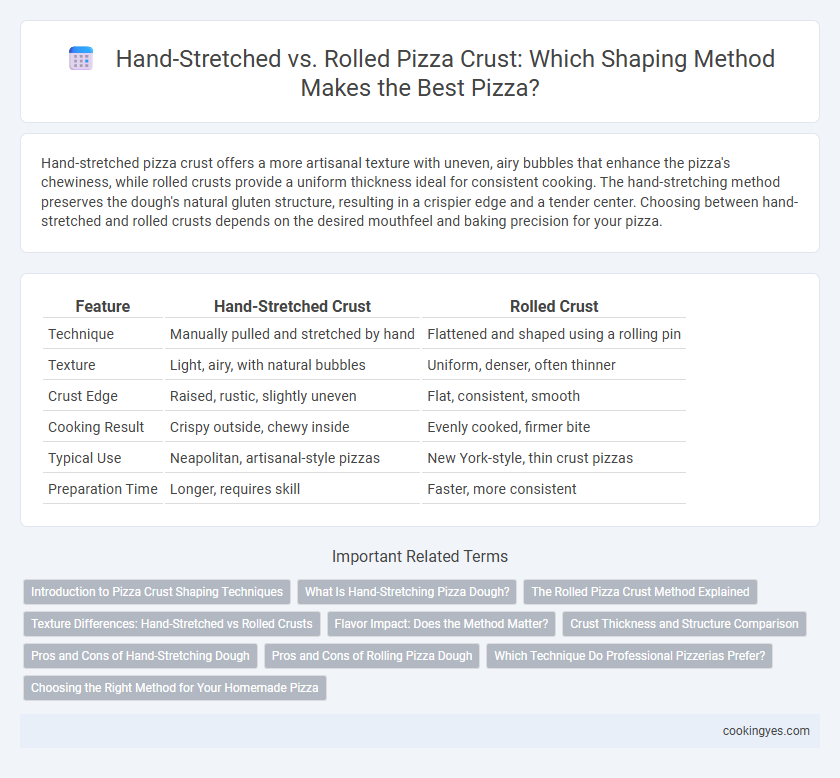Hand-stretched pizza crust offers a more artisanal texture with uneven, airy bubbles that enhance the pizza's chewiness, while rolled crusts provide a uniform thickness ideal for consistent cooking. The hand-stretching method preserves the dough's natural gluten structure, resulting in a crispier edge and a tender center. Choosing between hand-stretched and rolled crusts depends on the desired mouthfeel and baking precision for your pizza.
Table of Comparison
| Feature | Hand-Stretched Crust | Rolled Crust |
|---|---|---|
| Technique | Manually pulled and stretched by hand | Flattened and shaped using a rolling pin |
| Texture | Light, airy, with natural bubbles | Uniform, denser, often thinner |
| Crust Edge | Raised, rustic, slightly uneven | Flat, consistent, smooth |
| Cooking Result | Crispy outside, chewy inside | Evenly cooked, firmer bite |
| Typical Use | Neapolitan, artisanal-style pizzas | New York-style, thin crust pizzas |
| Preparation Time | Longer, requires skill | Faster, more consistent |
Introduction to Pizza Crust Shaping Techniques
Hand-stretched pizza crusts retain a light, airy texture by gently pulling the dough, preserving gas bubbles for an artisanal bite. Rolled crusts offer uniform thickness and a consistent texture, ideal for thin and crispy styles. Both techniques influence dough elasticity, hydration, and final crust flavor profiles, shaping the pizza experience significantly.
What Is Hand-Stretching Pizza Dough?
Hand-stretching pizza dough involves gently pulling and rotating the dough by hand to evenly expand its size while preserving the airy texture and gluten structure. This traditional technique creates a more tender crust with uneven, natural bubbles that enhance flavor and mouthfeel. Unlike rolling, hand-stretching maintains dough integrity, preventing over-compression and ensuring optimal rise during baking.
The Rolled Pizza Crust Method Explained
The rolled pizza crust method involves using a rolling pin to evenly flatten and shape the dough, resulting in a uniform thickness and consistent texture throughout the crust. This technique is favored for producing a thinner, crispier base that cooks quickly and holds toppings effectively. By controlling dough thickness with precision, the rolled method ensures a reliable crust ideal for Neapolitan and New York-style pizzas.
Texture Differences: Hand-Stretched vs Rolled Crusts
Hand-stretched pizza crusts develop a light, airy texture with irregular bubbles due to gentle stretching, allowing gluten to relax and creating a tender bite. Rolled crusts, compressed by the rolling pin, tend to have a denser, firmer texture with a more uniform thickness, resulting in a chewier mouthfeel. Texture differences impact the final pizza experience, with hand-stretched crusts favored for artisanal, rustic pizzas and rolled crusts often used for consistent and quick preparation.
Flavor Impact: Does the Method Matter?
Hand-stretched pizza dough allows for a lighter, airier crust with uneven edges that enhance texture and flavor absorption, while rolled dough tends to be denser and more uniform, resulting in a chewier bite. The hand-stretching technique preserves more of the dough's natural bubbles, which contributes to a more complex, slightly fermented taste. Choosing between hand-stretched or rolled dough affects not only the crust's texture but also its ability to carry toppings and sauce flavors, ultimately influencing the overall pizza experience.
Crust Thickness and Structure Comparison
Hand-stretched pizza crust offers a varied thickness with a slightly thicker, chewier edge and a thin center, creating an airy, open crumb structure ideal for Neapolitan-style pizzas. Rolled crust provides a uniformly thin, dense base and edge, resulting in a crispier texture that supports heavier toppings commonly found in New York-style slices. The choice between hand-stretched and rolled crusts directly influences dough elasticity, gluten formation, and final bite, catering to distinct regional pizza styles and preferences.
Pros and Cons of Hand-Stretching Dough
Hand-stretched pizza dough offers a unique texture with a light, airy crust and uneven, rustic edges favored in artisan pizzerias. It allows for greater control over dough thickness and air bubbles, enhancing flavor development and crispiness but requires skill and practice to avoid tearing. This method is time-consuming and less consistent compared to rolled dough, which can produce uniform crusts ideal for high-volume, fast-paced pizza production.
Pros and Cons of Rolling Pizza Dough
Rolling pizza dough creates a consistently thin and even crust, which ensures uniform cooking and a crisp texture preferred in styles like New York and thin-crust pizzas. However, rolling can compress the dough's air bubbles, resulting in a less airy and chewy texture compared to hand-stretched dough. This method is faster and more accessible for beginners but may sacrifice the artisanal characteristics that hand-stretched crusts offer.
Which Technique Do Professional Pizzerias Prefer?
Professional pizzerias predominantly prefer hand-stretched pizza crusts for their superior texture, allowing for a lighter, airier base with more nuanced chewiness compared to rolled dough, which can result in a denser crust. Hand-stretching preserves the dough's gluten structure, enabling even cooking and a characteristic blistered edge, prized in Neapolitan and artisan-style pizzas. This technique aligns with traditional craftsmanship, offering enhanced control over dough thickness and shape, critical for high-quality pizza production.
Choosing the Right Method for Your Homemade Pizza
Hand-stretched pizza crust achieves a light, airy texture by gently pulling the dough, preserving gas bubbles for an authentic Neapolitan-style base, while rolled crusts create a uniformly thin and crisp foundation ideal for thicker toppings. Choosing the right method depends on desired texture and cooking style; hand-stretching suits high-temperature ovens and softer doughs, whereas rolling offers consistent thickness and ease for home ovens. Mastering these techniques enhances the overall pizza experience by aligning crust characteristics with topping combinations and baking equipment.
Hand-Stretched vs Rolled for Pizza Crust Shaping Infographic

 cookingyes.com
cookingyes.com